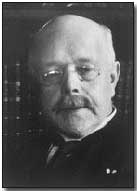Who's Who - Walter Nernst
 Professor Walter Hermann Nernst
(1864-1941) was an early pioneer of Germany's chemical weapons research
programme during World War One.
Professor Walter Hermann Nernst
(1864-1941) was an early pioneer of Germany's chemical weapons research
programme during World War One.
Nernst studied at the universities of Zurich, Berlin and Graz where he learnt physics and mathematics. He graduated from Wurzburg in 1887 with a thesis on electromotive forces produced by magnetism in steel plates.
1905 brought Nernst an appointment as Professor of Chemistry (later of physics) at the University of Berlin.
Although Fritz Haber is more usually credited with responsibility for driving forward Germany's chemical weapons research initiative, it was Nernst who initially argued the military benefits of using chemical agents as a weapon.
To this end Nernst suggested in 1914 the placement of an irritant powder, dianisidine chlorsulphate, among bullets in shrapnel shells so as to obtain an additional lachrymatory effect (i.e. tear gas).
Although implemented as suggested the experiment was itself a failure, with the Allied troops who faced it at Neuve Chapelle on 27 October 1914 noticing nothing unusual (and, it is said, German Army Chief of Staff Erich Falkenhayn's son won a case of champagne for remaining in a cloud of the substance for a full five minutes without exhibiting any signs of discomfort).
As a consequence of the experiment's failure Nernst returned to his laboratory in Berlin and played no further role in German wartime chemical weapons production, although his ideas were utilised and expanded upon by others, including Haber.
In 1920 Nernst received the Nobel Prize for Chemistry (two years after Haber received the same honour) for his pre-war work on heat theory and photochemistry. In 1924 he was appointed Director of the newly-founded Physikalisch-Chemisches Institut, a position he retained until his retirement in 1933.
Ernst had two sons, both of whom were killed in the First World War. He died in 1941.
A 'corkscrew' was a metal post for supporting a wire entanglement, with a twisted base enabling it to be screwed into the ground, removing the need for a hammer, the use of which could attract enemy fire.
- Did you know?
